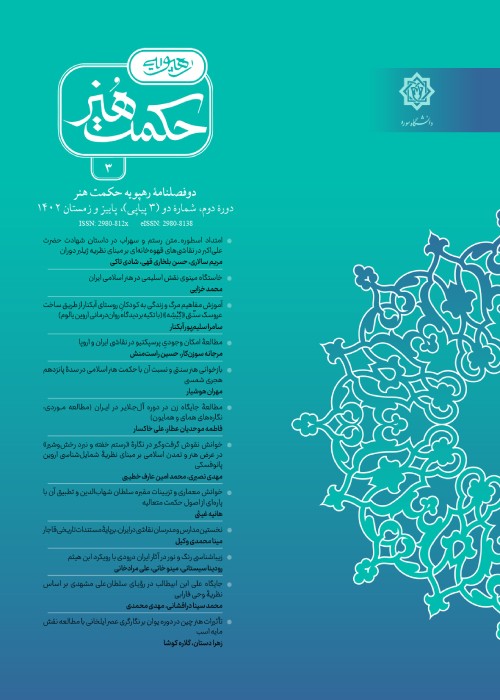Analysis of metamorphosis from Mullah Sadra's point of view in the short film "The Animal"
Author(s):
Article Type:
Research/Original Article (بدون رتبه معتبر)
Abstract:
Metamorphosis and its occurrence levels have been widely discussed by many religions, philosophers and schools. In the religion of Islam, metamorphosis is mentioned in the Holy Qur'an and exists in the thoughts and opinions of Muslim philosophers such as Mulla Sadra. In most cases, the explanation of metamorphosis and its introduction depends on understanding its difference with reincarnation; especially Mulla Sadra has made many efforts in this field. Many ethnic groups believe in reincarnation. In reincarnation, after separating from the human body, the soul belongs to the embryo or another body, but in metamorphosis, the soul is not separated from the body, and only the shape and form of the body changes to warn the people. In other words, the appearance of a human being changes to that of an animal, but the soul of a sinful human does not descend from a human position to an animal position. The views presented about metamorphosis can be classified into three main groups: metamorphosis of appearance, metamorphosis of the soul, metamorphosis of the soul and human body. Among the philosophers of transcendental wisdom, Mulla Sadra believes in the occurrence of sequential metamorphosis. First, he considers the metamorphosis to be realized in the level of the human soul, and then he refers to the subordination of the body to the soul. According to Mulla Sadra's opinion, bodies are subordinate to the soul, and therefore when the soul changes due to lust, anger, fear, happiness and similar things, the body also changes and as a result, the appearance also depends on the inside and due to the connection to It, gets distorted. The main issue of this article is the introduction of the main character of the movie " The Animal " as an example of metamorphosis of soul and body. The purpose of this research is to explain the levels of spiritual-physical metamorphosis in the hero of the film "The Animal" and to introduce him as an allegory of a metamorphosed human being. For this purpose, we will answer these questions: To what extent has the hero of "The Animal" reflected the examples of spiritual-physical metamorphosis considered by Mulla Sadra? To what extent have the soul and body of the hero become subordinated from each other? Watching related films and of course the entry of innovative and experimental cinematographers' works with new and creative topics into the field of written scientific research is very important and accordingly, it is necessary to have the opportunity to criticize, analyze and introduce these works with a formalistic approach in the scientific community, so that more and diverse studies can be done on this kind of experimental films. This descriptive-analytical research is of a fundamental type and is in line with theoretical studies in the field of Islamic philosophy. The necessary information and data have been collected through library studies and authoritative articles. First, the theoretical issues were raised and then the short film of "The Animal" was analyzed based on the theoretical framework of the research. Based on this, some scenes from the film showing the levels of mental-physical metamorphosis were selected and analyzed. According to the analysis that emerged from the scenes/shots of the film, the hero of the film "The Animal", was recognized and introduced as a model and example, and in fact, a very close allegory for spiritual-physical metamorphosis. The issue of escape from the situation, has a psychological effect on the hero's daily life and his whole life is affected by the subject of escape. To such an extent that it doesn't take long for the spiritual influences to take over the hero's body completely and make him involved in a spiritual-physical metamorphosis. Although the hero has been shot and wounded, he manages to escape and cross the border by enduring fear and hardship and without considering the dangers. Because of the value he attaches to his goal, he tests his soul and body in this way. By killing a ram and imitating the behavior of the animal, he becomes him and experiences the dream of escaping. In response to this research question, that to what extent the hero has reflected the examples of spiritual-physical metamorphosis considered by Mulla Sadra, the findings indicate that the hero's soul, due to the experience of fear, anger and many failures on the way to his goal and Insisting on fulfilling his spiritual desire (crossing the border), first degrades himself to the level of an animal soul, and in the second instance, he commits his physical metamorphosis by killing a ram. Muslim philosophers believe that a person's identity does not change with the change of appearance. In the film, the hero, in addition to remaining human, wears the guise of a ram on his body and has both aspect at the same time.
Keywords:
Language:
Persian
Published:
Journal of Rahppoye, Hekmat-e Honar, Volume:1 Issue: 1, 2022
Pages:
107 to 120
magiran.com/p2519501
دانلود و مطالعه متن این مقاله با یکی از روشهای زیر امکان پذیر است:
اشتراک شخصی
با عضویت و پرداخت آنلاین حق اشتراک یکساله به مبلغ 1,390,000ريال میتوانید 70 عنوان مطلب دانلود کنید!
اشتراک سازمانی
به کتابخانه دانشگاه یا محل کار خود پیشنهاد کنید تا اشتراک سازمانی این پایگاه را برای دسترسی نامحدود همه کاربران به متن مطالب تهیه نمایند!
توجه!
- حق عضویت دریافتی صرف حمایت از نشریات عضو و نگهداری، تکمیل و توسعه مگیران میشود.
- پرداخت حق اشتراک و دانلود مقالات اجازه بازنشر آن در سایر رسانههای چاپی و دیجیتال را به کاربر نمیدهد.
In order to view content subscription is required
Personal subscription
Subscribe magiran.com for 70 € euros via PayPal and download 70 articles during a year.
Organization subscription
Please contact us to subscribe your university or library for unlimited access!



